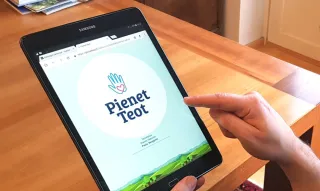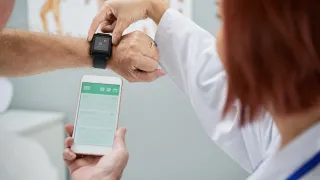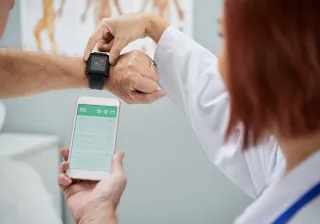VTT’s Smart Health researchers would harness citizens’ personal health data for the prevention of illnesses. Intelligent data analysis could, for example, support the physician by assessing your risk for memory disorders or type 2 diabetes during your everyday visit to the health centre.
VTT’s Smart Health researchers share a vision of the digital future of health care. Intelligent data analysis and Finland’s excellent health data resources offer an opportunity to develop effective disease screening methods.
“We develop tools for general practitioners for assessing the patients’ personal risk of developing a certain disease”, says Research Professor Markus Forsberg.
Data collected by the patient and analysed automatically using intelligent data analysis tools could support screening and diagnosis of memory disorders at much earlier stage than what is possible today.
“We study and develop methods for interpreting health data using modern, transparent machine learning and AI techniques”, says Principal Scientist Juha Pärkkä.
Producer and interpreter of data
VTT has competence in sensor development, data analytics and service design. Intelligent data analytics shows its value when there is a large quantity of good-quality, reliable data. VTT’s sensor development aims to create new, reliable sensor solutions. Intelligent data analysis tools create an overview of the patient’s health status using data from several different sources.
“Service design helps to create easy-to-use, attractive applications to meet the needs of both patients and physicians”, says Markus Forsberg.
Biomedical engineering research started at VTT as early as in the 1970s when the VTT Medical Engineering Laboratory was founded in Tampere. In the middle of the 1990s, work was done in the VTT Information Technology unit, where Principal Scientist Juha Pärkkä started his career at VTT in 1997. The current Smart Health research team facilitates everyday health care for both health care professionals and patients.
“We develop software for physicians to support diagnosis and for patients to support prevention and self-care”, says Pärkkä.
“In a typical project, we have a lot of heterogeneous data for building a comprehensive picture to support, for example, screening for diseases or making decisions on self-care.”
Juha Pärkkä wrote his dissertation on wearable sensor data analytics. Modern smart watches and a ring measure movement, heart rate, oxygen saturation and even blood pressure 24/7. The data are collected unobtrusively as part of normal everyday life, and can be used to support treatment and self-care. In case of chronic disorders, for example, routine health care visits can be planned for individual needs, not at fixed intervals like now.
“In other words, technological solutions can help to reduce unnecessary health care visits”, says Pärkkä.
“And if the patient’s care pathway is tailored individually with the help of technology, health care resources could be targeted where there is greatest need”, says Markus Forsberg.
Markus Forsberg is a newer member of the VTT family. Markus Forsberg is a research professor based in Kuopio, where he builds solutions for early identification and monitoring of illnesses and guiding of care pathways to meet the needs of primary care. In addition to his work at VTT, he is also a Professor of Pharmacology at the University of Eastern Finland. Forsberg is very familiar with every day health care.
“If we want to use technology to make the use of health care resources more efficient, the tools must really work at the doctor’s desk”, says Forsberg.
Some of VTT's innovations are already in clinical use. Combinostics, a spin-off company established by VTT’s researchers, is a good example of VTT’s expertise. The company's software analyses brain images together with results from blood samples and many different tests, and compares the results with extensive patient databases.
“Diagnosis of memory disorders requires combination and analysis of data from several sources. The software does this and helps the physician to get an overview of the patient status. This way it supports the physician in diagnosing dementia”, explains Pärkkä.

Intelligent data analytics and everyday health care
The researchers working on VTT’s intelligent data analytics solutions have a clear division of responsibilities. The Smart Health researchers in Tampere are familiar with health care data resources and can put AI algorithms to work, and the researchers in Kuopio know the needs of health care users and how to pilot new solutions.
“This is a positive situation for me. We come up with the idea to build a certain concept and ask the researchers in Tampere how to do that in practice”, laughs Markus Forsberg.
Thanks to the Koronavilkku application that aims to slow down the COVID-19 pandemic, many Finns have become familiar with digital health care tools. Relative to population size, it is the world's most popular COVID-19 application and it has delivered concrete benefits to breaking the chains of infection. Similar digital tools could also be used in the early diagnosing of several lifestyle diseases. According to the researchers, we are well-placed to do that. We have a positive attitude towards the use of technology.
However, utilizing personal health data in preventive health care involves a lot more than technological solutions. Legislation, data protection, politics and attitudes also play an important role in the proliferation of data-based health care solutions.
“Technology might be the easiest part after all”, the researchers say.
So how could we realise the vision where patient-generated health data and intelligent data analytics supported the physician in evaluating the patient's risk for lifestyle diseases already at the first encounter?
As an example, the researchers mention memory disorders, on which groundbreaking research has been conducted in Finland. According to research data, prevention is the best way to treat memory disorders. This requires early identification of the increased risk.
Nowadays, a memory disorder is often recognised too late. When a spouse or child first suspects that an ageing loved one could have problems with memory, it might still take several months before the first visit to a general practitioner.
“In Europe, the diagnosis takes an average of 20 months”, say the researchers.
Wearable sensors and self-monitoring could significantly speed-up the cycle.
“We get a lot of information just by monitoring normal life and activity. For example, the quality of sleep gets worse at the early stage of several chronic illnesses”, says Juha Pärkkä.
At best, wearable sensors indicate an illness long before any human-detectable symptoms occur.
GP’s helper
Thanks to long-term research, the risk groups for memory disorders and diabetes are well-known in Finland. The next step is to harness information technology to provide personal risk assessments.
The work of general practitioners could be supported by an algorithm that is able to combine information from an online cognition test performed before the appointment with all personal health data collected over the years. Intelligent data analytics would help the physician by automatically comparing the information about the person sitting in the clinic with data from thousands or even millions of patient cases. At the moment, data analysis is most beneficial to specialists but in the future it will certainly help GPs as well. VTT’s spin-off company Combinostics has already turned this type of solutions into products to support earlier diagnosis of people with memory disorders.
Intelligent data analysis would help the physician to get an overview of the patient status and make a diagnosis. If the risk of memory disorder is deemed high, the interventions can be started right away.
“Patients with lower risk will be monitored, and the cognition test can be repeated in, for example, three months”, says Markus Forsberg.
Risk assessment and supporting the physician in the diagnosis is one way of ensuring more efficient use of health care resources.
“We have a good FINGER model to support the memory and cognitive functions of the elderly. But the reality is that without help from the digital tools, it cannot be applied to all people in the risk group. We do not have enough health care resources to follow and guide all patients in the clinics. With help from the digital tools, the interventions can be focused on the individuals needing them most”, says Forsberg.
VTT has already developed technology for assessing the patient’s personal risk of developing a memory disorder or diabetes but a lot of work is needed before it becomes an everyday tool for physicians. Even if the technology could be integrated to the information systems in the social and health care districts, its application in clinical practice cannot be taken for granted.
“In this type of project, we should collaborate with both health care decision-makers and large health care stakeholders. VTT can build the necessary technology but we need a large group of experts toapply it”, says Markus Forsberg.
Personal data analysis identifies high risk of dementia
In the National Programme on Ageing published in October 2020, the Ministry of Social Affairs and Health proposed nationwide introduction of the FINGER model by 2030. The model helps to prevent the risk of memory disorders.
The Finnish FINGER study was the first study in the world to show that prevention is the most efficient treatment of memory disorders. The FINGER model is a lifestyle programme based on this study. It helps the ageing risk population to exercise, eat healthy and exercise their brain.
VTT has been involved in the development of the cognitive tests.
“We would like to develop the patient risk indicator further and make it more individual. That would help health care personnel to evaluate how each patient could benefit from the FINGER model”, says Markus Forsberg.
Finland has invested heavily in the research on memory disorders. As a result, we have large quantities of valuable research data and a new model for preventing the disorder. Researchers believe that introducing risk assessment and monitoring tools throughout primary care would improve the treatment of patients with memory disorders and lead to more efficient use of health care resources.
“We want to support the introduction of the model and its use in the office of every health centre physician”, says Forsberg.
Author: Petja Partanen






